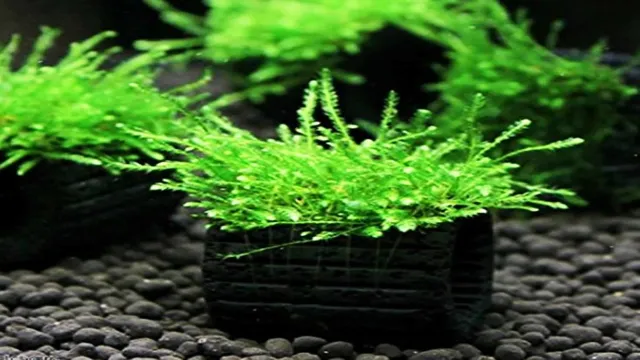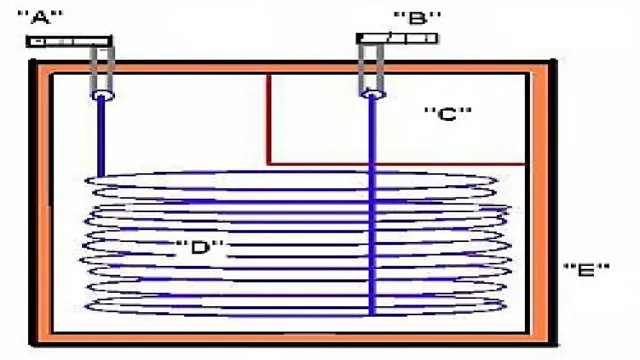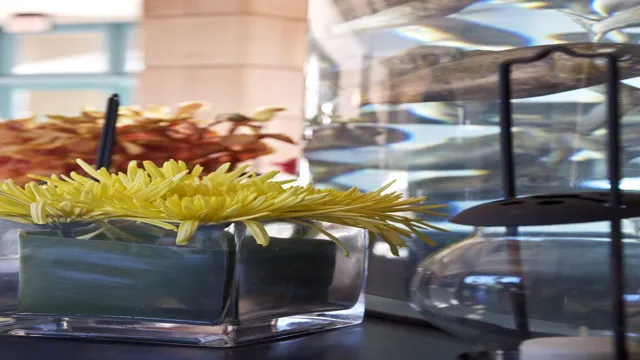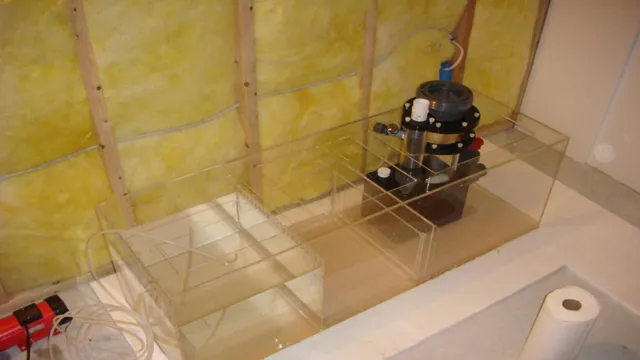Are you a lover of aquascaping and want to add some greenery to your aquarium? If so, then you need to know about growing carpet aquarium plants. These plants not only add aesthetic value to your aquarium but also provide a home for your aquatic creatures. However, it can be a bit tricky to grow them, and that’s where we come in! Firstly, it’s essential to choose the right substrate and lighting for your plants.
Substrates like sand or fine-grained gravel will provide a good base for your plants to anchor themselves and grow successfully. As for lighting, ensure that your aquarium receives enough light intensity, duration, and quality to promote photosynthesis and healthy growth. Next, you need to choose the right carpet plants.
Dwarf Hairgrass, Monte Carlo, and Java Moss are among the most popular types of carpet plants used in aquariums. Each plant has different care requirements, so make sure you research the specific needs of each before planting them. Once you’ve chosen your plants, it’s time to start growing them.
One of the best ways to encourage carpet plants to grow evenly and thickly is by trimming them regularly. Regular trimming helps in removing yellow or dead leaves, enabling proper light penetration to lower plants and healthy growth. In conclusion, growing carpet aquarium plants requires both careful planning and execution.
With the right substrate, lighting, and plant selection, you can create a beautiful and healthy carpet of greenery in your aquarium. So, go ahead and try your hand at growing a carpet of aquarium plants, and you’ll be amazed at the results!
Choosing the Right Carpet Plant
When it comes to choosing the right carpet aquarium plant for your tank, there are a few things to consider. First, you’ll want to think about the size of your tank and how much light it gets. Some carpet plants require high light levels to thrive, while others can do well in lower light conditions.
You’ll also want to consider the temperature and water parameters in your tank, as some plants prefer certain conditions. Another important factor to consider is the growth rate of the plant – some carpet plants grow quickly and will require regular trimming, while others grow more slowly. Ultimately, it’s important to do your research and choose a plant that will be well-suited to your specific aquarium setup.
With the right plant, you can create a beautiful and thriving carpet in your aquarium that will be a delight to behold.
Consider Lighting and CO2 Levels
Carpet plants are a popular choice for aquariums due to their ability to provide a lush, green carpet effect on the tank floor. When choosing the right carpet plant for your aquarium, it is important to consider lighting and CO2 levels. Different carpet plants have varying requirements when it comes to lighting and CO2 levels, so it’s essential to research each plant individually before making a decision.
Some carpet plants prefer high lighting and CO2 levels, while others do well with moderate to low levels. It’s important to strike a balance that suits the needs of both the plant and your aquarium inhabitants. By doing so, you can create a healthy and vibrant aquatic environment that all of your fish will love.

Choose a Fast-growing and Hardy Plant
When it comes to choosing a carpet plant, there are a few things you’ll want to keep in mind. First and foremost, you’ll want to choose a plant that is fast-growing and hardy. This will ensure that your carpet grows quickly and can withstand any environmental factors.
One great option is the dwarf hairgrass plant. Not only is it fast-growing, but it’s also relatively easy to care for and can survive in a wide range of water conditions. Additionally, it has a beautiful green color that will add a pop of color to your aquarium.
With the right care, your dwarf hairgrass can create a lush and vibrant carpet that will impress anyone who sees it. So, don’t be afraid to try different plants until you find one that works best for you and your aquarium. (See Also: How to Drill and Setup an Overflow on an Aquarium: Tips and Techniques)
Preparation and Set-up
Growing a carpet aquarium plant requires careful preparation and set-up. First, you need to choose the right substrate, such as nutrient-rich soil or fine sand. Then, you need to add adequate lighting, CO2, and fertilizers to support plant growth.
Choosing the right plants is also important. For example, carpet plants like dwarf hairgrass, Monte Carlo, and glosso are popular choices. Once you have all the necessary materials, it’s time to set up the aquarium.
It’s important to create a sloping substrate to allow for proper drainage and prevent dead spots. Additionally, creating a plant-friendly environment requires adequate water flow and filtration, and a consistent temperature and pH level. Taking these steps and ensuring the plant has all the necessary nutrients and conditions will help produce a beautiful and healthy carpet aquarium plant.
Choose the Right Substrate
When it comes to creating the perfect habitat for your pet, choosing the right substrate is key. This means finding a material that provides comfort, easy maintenance, and mimics their natural environment. Before choosing a substrate, it’s important to consider the specific needs of your pet.
Do they require a dry or humid environment? Are they burrowers or climbers? Once you’ve determined their needs, you can begin selecting the appropriate substrate. For example, a reptile that requires a dry environment may need a substrate made of coconut fiber or desert sand. While a snake that likes to burrow would benefit from a mix of aspen and cypress mulch.
It’s also crucial to properly set up the substrate in the enclosure. Depending on the species, some animals may need deeper layers of substrate to allow for burrowing or hiding. Make sure to regularly maintain and replace the substrate as needed to ensure a clean and healthy living space for your pet.
Choosing the right substrate will not only provide a comfortable home for your pet, but also contribute to their overall well-being.
Add Fertilizers and Nutrients
When setting up your garden, it’s important to prepare the soil and add fertilizers and nutrients to ensure your plants can flourish. Before planting, turn over the soil and remove any debris or rocks that may hinder growth. Once the soil has been prepared, it’s time to add fertilizers and nutrients.
A popular option is to use organic fertilizers such as compost or manure. These natural options not only add nutrients to the soil, but also improve soil structure and promote healthy microbial activity. However, if using chemical fertilizers, it’s important to follow instructions carefully to avoid over-fertilizing and potentially harming your plants.
Incorporating a balance of nutrients such as nitrogen, phosphorus, and potassium can also help promote healthy plant growth. Remember to always research the specific needs of the plants you are growing to ensure they receive the appropriate amount of nutrients for optimal growth. By taking the time to properly prepare the soil and add necessary fertilizers and nutrients, your garden can thrive and produce a bountiful harvest.
Planting Techniques and Spacing
When it comes to planting techniques and spacing, preparation and set-up play a crucial role in ensuring a successful harvest. Firstly, it’s essential to assess the soil’s fertility, composition, and acidity levels to determine if it’s optimal for the chosen plants. The next step is to prepare the ground by clearing away any debris, rocks, or weeds that could interfere with growth.
Once the soil is loosened and tilled, adding fertilizers, compost, and organic matter can improve its quality, leading to better yields. After that, it’s essential to plan the spacing of the plants, determining the recommended distance between each row and plant. Spacing helps the plants receive sufficient light, air, and nutrients.
Close planting can cause the plants to compete for resources, leading to stunted growth and overcrowding. In contrast, too sparse planting can cause soil erosion and leave the ground open to weed infestation. In summary, preparation and set-up are vital as they help ensure that the planted crops have the best environment to thrive and achieve their full potential. (See Also: Will Aquarium Salt Kill Snails? A Comprehensive Guide to Snail Management)
Maintenance and Care
If you’re looking to add some greenery to your aquarium, carpet plants are a great option. Not only do they provide a natural habitat for your fish, but their spreading growth pattern can also add a sense of depth and complexity to your tank. However, growing carpet plants can be a bit tricky at times, so there are a few things to keep in mind.
Firstly, they require a lot of light, so make sure your aquarium is situated in a well-lit area or invest in some high-tech lighting. Additionally, ensure that the substrate in your tank has plenty of nutrients to help the plants thrive. Finally, be mindful of water flow and filtration, as too strong a current can uproot the fragile carpet plants.
With a bit of patience and attention to detail, you’ll be able to achieve a carpet full of lush, green growth in no time!
Regular Pruning and Trimming
Regular pruning and trimming are essential to maintain the health and beauty of your trees and shrubs. Pruning is the process of removing dead, diseased, or damaged branches, while trimming involves shaping and maintaining the growth of the plant. Neglecting to do either can lead to unhealthy growth and an unattractive appearance.
Proper pruning and trimming allow for air and sunlight to reach all parts of the plant, promoting even growth and reducing the risk of pests and diseases. Regular upkeep also helps to keep the plant at a manageable size, preventing it from overtaking the surrounding landscape. Hiring a professional tree care service can be a wise investment, as they have the knowledge and tools necessary to perform these tasks safely and effectively.
By keeping up with regular pruning and trimming, you can ensure your trees and shrubs thrive for years to come.
Proper Watering and Feeding
Proper watering and feeding are critical aspects of maintaining the health and growth of your plants. Watering frequency and amount depend on the plant type, size, and soil type. Most plants require consistent moisture, but overwatering can be detrimental.
The ideal way to check for moisture is to stick your finger in the soil up to the second knuckle and see if it feels dry. As for feeding, plants need the right balance of nutrients to thrive. You can use a slow-release fertilizer or organic matter like compost.
It’s essential to follow the instructions for the type of plant and fertilizer you’re using to avoid overfeeding, which can also harm your plants. Remember, just like people, plants need adequate hydration and nutrition to reach their full potential. So give them the love and care they deserve, and they’ll reward you with healthy growth and beautiful blooms.
Troubleshooting Common Issues
When it comes to growing a carpet aquarium plant, there are a few common issues that many aquarists may run into. One issue that can arise is poor lighting. Carpet plants require high levels of light in order to thrive, so it’s important to ensure that your aquarium has the appropriate lighting in place.
Another issue that can hamper the growth of carpet plants is nutrient deficiency. Ensuring that your aquarium has the proper balance of nutrients, including carbon dioxide and fertilizers, can help your carpet plants grow more effectively. Finally, overcrowding can also be a problem when growing carpet plants.
Ensuring that your plants have sufficient space to grow and aren’t being overshadowed by other plants or structures in your aquarium can help them thrive. By addressing these common issues, you can help your carpet plants grow into a lush and healthy aquatic carpet. (See Also: How to Get Algae Off of Aquarium Decorations: Tips and Tricks for a Clean Tank)
Conclusion
In conclusion, growing a carpet aquarium plant can be a rewarding and fulfilling experience for any aquarist. Like any plant, it requires proper care and attention to thrive in its aquatic environment. However, with a little patience, the right lighting, and a nutritious substrate, you too can enjoy the lush, green carpet of aquatic vegetation that your fish will love.
So dive in and get started, and before you know it, you’ll have a “fur” rug for your fish to play on!”
FAQs
What are some commonly used carpet aquarium plants?
Some commonly used carpet aquarium plants include dwarf hairgrass, java moss, and Monte Carlo.
How do you successfully grow carpet aquarium plants?
To successfully grow carpet aquarium plants, provide plenty of light and nutrients, maintain stable water parameters, and ensure good circulation and aeration.
Can carpet aquarium plants be grown without CO2 injection?
Yes, some carpet aquarium plants can be grown without CO2 injection, but they may grow more slowly or not as densely as plants with CO2 supplementation.
How often should carpet aquarium plants be trimmed?
Carpet aquarium plants should be trimmed as needed to maintain the desired height and shape, usually every few weeks.
What is the best substrate for growing carpet aquarium plants?
The best substrate for growing carpet aquarium plants is one that is nutrient-rich, fine-grained, and has good water retention, such as aquasoil or fluorite.
What kind of lighting is required for carpet aquarium plants?
Carpet aquarium plants require high-intensity LED or fluorescent lighting of at least 3 watts per gallon to ensure proper growth and photosynthesis.
How do you prevent algae growth on carpet aquarium plants?
To prevent algae growth on carpet aquarium plants, maintain the proper lighting, nutrient levels, and water parameters, use a photoperiod of 8-10 hours per day, and clean the aquarium regularly.







